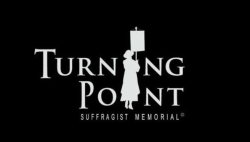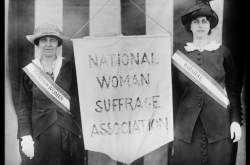Honoring the Women Who Gave So Much: Turning Point Suffragist Memorial
The Turning Point Suffragist Memorial Association is dedicated to honoring the suffragists, who fought for and won women’s right to vote.

Its vision is to raise awareness and funds to create a memorial that will reflect the strength of these women and the significance of their struggle.
In partnership with NOVA Parks, the memorial will be located in Fairfax County, VA, near the spot where women were imprisoned.
And its goal is to raise funds to complete construction and have the national memorial fully operational by 2020, the 100th anniversary of the 19th Amendment which recognized woman’s right to vote.
 If Executive Director Pat Wirth, former chairwoman Jane Barker, and a slew of activists have their way, the garden-style national memorial will be grand. It will commemorate the suffrage struggle, and educate, inspire, and empower present and future generations to remain vigilant in the quest for equal rights.
If Executive Director Pat Wirth, former chairwoman Jane Barker, and a slew of activists have their way, the garden-style national memorial will be grand. It will commemorate the suffrage struggle, and educate, inspire, and empower present and future generations to remain vigilant in the quest for equal rights.
In this issue of Grateful American™ Magazine, we interview Pat Wirth (above right), and historian Edie Mayo (above left), who share insights into this fascinating topic and important project.
 Hope Katz Gibbs: Pat, tell us how the Turning Point Suffragist Memorial Association came to be.
Hope Katz Gibbs: Pat, tell us how the Turning Point Suffragist Memorial Association came to be.
Pat Wirth: In 2007, the manager at the Occoquan Regional Park approached the League of Women Voters in Fairfax, VA, to explore the idea of building a memorial to the suffragists in his park — part of the historic DC Prison grounds where scores of suffragists were jailed for silently picketing the White House in 1917. A committee of women began meeting under Northern Virginia Regional Park Authority’s nonprofit foundation to explore and expand on the concept. (They changed their name to NOVA Parks earlier this year.)
In 2011, the women, at the recommendation of attorney members, formed a 501(c)(3), the Turning Point Suffragist Memorial Association. Robert Beach, an award-winning architect, donated the design. The group has an Interpretation and Design Committee that has been researching the historical information that will go into the 19 information stations that will tell the entire 72-year history of the suffrage movement. The memorial will have 19 stations because it was the 19th Amendment that gave women the vote!
 David Bruce Smith: Pat, how did your involvement begin?
David Bruce Smith: Pat, how did your involvement begin?
In 2012, I became a member of the association when I saw an exhibit about the organization at a fall arts festival in the tiny town of Occoquan across from the park. Jane Barker, the founder of the organization, is a friend of mine who encouraged me to attend a fund-raising dinner and then some meetings. Turning Point hired me as its executive director on May 1, 2015.
Hope Katz Gibbs: Edie — Take us back to the mid-1800s when the suffragist movement began, and give us a brief history.
Edie Mayo: In the mid-1800s, women were subjected to many legal disabilities, which had come down through English common law. If married, women even lacked their own individual legal identities, which were subsumed in their husband’s identity. Women lacked property rights, rights to their own wages, even rights to their own children — and they did not have the most basic right of citizenship — the right to vote.
Many women were involved in the anti-slavery movement, which awakened them to their own lack of rights as women. They began to organize to change their legal status. After the Civil War, two groups emerged to work for women’s right to vote: The American Woman Suffrage Association, led by Lucy Stone and Julia Ward Howe, which had a moderate agenda to achieve voting rights state by state; and the National Woman Suffrage Association, led by Elizabeth Cady Stanton and Susan B. Anthony, which was more militant about achieving other legal rights for women and advocated a Constitutional amendment to gain women the right to vote.
 David Bruce Smith: Then, in 1890, the two groups merged to become the National American Woman Suffrage Association, led by Carrie Chapman Catt.
David Bruce Smith: Then, in 1890, the two groups merged to become the National American Woman Suffrage Association, led by Carrie Chapman Catt.
Edie Mayo: That’s right. In the nineteen teens, Alice Paul, Lucy Burns, and Harriot Stanton Blatch (daughter of Elizabeth Cady Stanton) returned from England where they had been active in the British suffrage movement. They brought with them new tactics — such as open-air meetings, marches, and parades — in addition to aggressive lobbying, which they applied to the American movement. In 1916, these women formed the National Woman’s Party. With the larger, more moderate NAWSA pushing from one side, and the more militant Woman’s Party pushing from the other, these groups forced President Woodrow Wilson and the Congress to deal with the issue of women voting as a serious national issue.
 David Bruce Smith: Edie — Tell us what has happened in the years since, and why this project is so important.
David Bruce Smith: Edie — Tell us what has happened in the years since, and why this project is so important.
Edie Mayo: This rich history — which involves more than half the citizens of this nation — is virtually unknown. I like to call it “the best-kept secret in American History.” The history of women’s suffrage rarely receives more than a short paragraph in general history texts, and you would have to major in women’s history in college to really learn about this important part of our nation’s past.
 Hope Katz Gibbs: Pat — You are trying to raise a funds to make this memorial come to fruition. How is it going?
Hope Katz Gibbs: Pat — You are trying to raise a funds to make this memorial come to fruition. How is it going?
Pat Wirth: We have a dual challenge raising funds. Most Americans know very little about the suffrage movement because it was omitted from our history texts. The mostly male textbook authors failed to recognize the 72-year fight women fought to win the vote and abridged the challenge to the Progressive Era, 1890 to 1920, when, in fact, the movement began in Seneca Falls, NY, in 1848.
Thousands of women from every state, race, creed, and nationality fought for 72-years to win the vote. So, our number-one challenge has been to educate the public about this missing piece of history — it’s difficult to ask folks for donations for something they know nothing about!
The second challenge is that we are not eligible for any government funding, and most foundations will not donate to a capital campaign. This will be a national memorial, and we have spent considerable time this year expanding our reach nationally to get the word out about the memorial through national women’s organizations. It takes a lot of time to build relationships.
 David Bruce Smith: Pat — If for some reason you don’t meet your funding goals, what will become of the Association?
David Bruce Smith: Pat — If for some reason you don’t meet your funding goals, what will become of the Association?
The Association will build a memorial with whatever funds it has collected; it may be a scaled-down version of the design if necessary. We have been assured by NOVA Parks that there will be a national memorial commemorating all the suffragists and the entire suffragist movement in the park.
Hope Katz Gibbs: Pat — You have an amazing background in business — having spent decades in the auto industry, which has traditionally been a man’s world. You know from firsthand experience that it’s not easy to be a strong woman in a male-dominated environment, and can surely relate to the plight of the suffragists. From your point of view, how do you think women should respond in the face of a challenge? And, do you see younger women — aka: the Millennials — standing up to this challenge?
Pat Wirth: As I mentioned earlier, we have the difficult task of educating everyone about this missing piece of American history, including the Millennials. Suffragist Elizabeth Cady Stanton actually likened women to slaves because of their limited role in society in the mid-19th century — if they married, their property went to their husbands; their children belonged to the husband; if they worked, their wages belonged to the husband; they could not belong to the professions and so could not become doctors or lawyers.
In the many presentations I give about the memorial to others, all are shocked to learn the truth about the treatment of women prior to winning the vote. Businesswomen now understand that without the vote they would not be in business! One of the shocking facts I like to share with my audience is that numerous state constitutions stated that “Idiots, lunatics, paupers, felons, and women shall not be entitled to vote.” That really gets their attention!
David Bruce Smith: Edie — I’d like to ask you the same question, but from a historic point of view.
Edie Mayo: I think women should open their pocketbooks and make certain that this memorial is built! But it has been an uphill battle. People contribute to causes they know and care about. Few Millennials know anything about this chapter in American history, so our first job is to educate and get them fired up about this cause.
Hope Katz Gibbs: Edie — In fact, there’s an amazing exhibit about the history of bicycles at the Smithsonian’s National Museum of American History, where you work. Tell us about how the bike has freed women, and why it’s important for us to know where we’ve been?
Edie Mayo: If you don’t know where you’ve been, it’s hard to know where you are going. Frances Willard, leader of the Woman’s Christian Temperance Union, and the most widely known and popular woman of the late 19th century, wrote a wonderful little book entitled, “How I Learned to Ride the Bicycle” (which she did later in life), in which she compared learning to ride a bicycle with learning to become independent and self-sufficient as a woman.
First, you have to learn to balance yourself, then to ride a moderate amount, and finally to set off on your own journey. She told women that this journey was not without risk — you might fall off the bicycle or you might not know which way to go at first. In the end, however, you get back up, set a course, and lead an independent and rewarding life.
David Bruce Smith: Pat — What’s your ultimate goal for the Turning Point Suffragist Memorial Association?
Pat Wirth: The ultimate goal is to see the full history of the suffrage movement come to light for all the American people. Women would not be where they are today if they had not won the vote. In addition, present and future generations must remain vigilant in the quest for equal rights. We intend to provide programs through our Turning Point Institute that will include topics such as leadership, public speaking, political candidacy, social awareness and responsibility, civil rights, fiscal acumen, etc.
Hope Katz Gibbs: Pat — The last question goes to you. As we mentioned earlier, you are an advocate for women’s rights. If you were queen for a day, what would the world look like for women in 10 years?
Pat Wirth: While women are slowly climbing the business ladder to greater success and occasionally cracking the glass ceiling, that is not happening in all levels of government. Today approximately 20 percent of all elected officials in local, state, and federal positions are women. That has to change so that women’s perspective in making our laws is equal to that of men. I believe this will lead to expanded equality for all.
Thank you all so much for your time and support!
For more information about the Turning Point Suffragist Memorial, visit suffragistmemorial.org.
And for more interesting interviews about American history, visit David Bruce Smith’s Grateful American™ Foundation at GratefulAmericanFoundation.com.
Here’s to restoring enthusiasm for American history in kids and adults!



